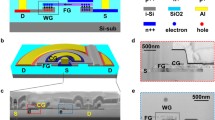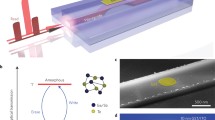Abstract
The increasing speed of fibre-optic-based telecommunications has focused attention on high-speed optical processing of digital information1. Complex optical processing requires a high-density, high-speed, low-power optical memory that can be integrated with planar semiconductor technology for buffering of decisions and telecommunication data2. Recently, ring lasers with extremely small size and low operating power have been made3,4,5,6,7, and we demonstrate here a memory element constructed by interconnecting these microscopic lasers. Our device occupies an area of 18 × 40 µm2 on an InP/InGaAsP photonic integrated circuit, and switches within 20 ps with 5.5 fJ optical switching energy. Simulations show that the element has the potential for much smaller dimensions and switching times. Large numbers of such memory elements can be densely integrated and interconnected on a photonic integrated circuit: fast digital optical information processing systems employing large-scale integration should now be viable.



Similar content being viewed by others
References
Cotter, D. et al. Nonlinear optics for high speed digital information processing. Science 286, 1523–1528 (1999)
Zimmerman, S., Wixforth, A., Kotthaus, J. P., Wegscheider, W. & Bichler, M. A semiconductor-based photonic memory cell. Science 283, 1292–1295 (1999)
Fujita, M., Ushigome, R. & Baba, T. Continuous wave lasing in GaInAsP microdisk injection laser with threshold current of 40µA. Electron. Lett. 36, 790–791 (2000)
Spillane, S. M., Kippenberg, T. J. & Vahala, K. J. Ultralow-threshold Raman laser using a spherical dielectric microcavity. Nature 415, 621–623 (2002)
Polman, A., Min, B., Kalkman, J., Kippenberg, T. J. & Vahala, K. J. Ultralow-threshold erbium-implanted toroidal microlaser on silicon. Appl. Phys. Lett. 84, 1037–1039 (2004)
Levi, A. F. J., McCall, S. L., Pearton, S. J. & Logan, R. A. Room temperature operation of submicrometre radius disk laser. Electron. Lett. 29, 1666–1667 (1993)
Baba, T. & Sano, D. Low-threshold lasing and Purcell effect in microdisk lasers at room temperature. IEEE J. Select. Top. Quant. Electron. 9, 1340–1346 (2003)
Van, V. et al. Optical signal processing using nonlinear semiconductor microring resonators. IEEE J. Select. Top. Quant. Electron. 8, 705–713 (2002)
Yanik, M. F., Fan, S. & Soljacic, M. High-contrast all-optical bistable switching in photonic crystal microcavities. Appl. Phys. Lett. 83, 2739–2741 (2003)
Keyes, R. W. Fundamental limits of silicon technology. Proc. IEEE 89, 227–239 (2001)
Kawaguchi, H. Bistabilities and Nonlinearities in Laser Diodes (Artech House, Boston, 1994)
Buczek, C. J., Freiberg, R. J. & Skolnick, M. L. CO2 regenerative ring power amplifiers. J. Appl. Phys. 42, 3133–3137 (1971)
Harder, C., Vahala, K. & Yariv, A. Measurement of the linewidth enhancement factor α of semiconductor lasers. Appl. Phys. Lett. 40, 328–330 (1983)
Sakai, A. & Baba, T. FDTD simulation of photonic devices and circuits based on fan-shaped microdisks. J. Lightwave Technol. 17, 1493–1499 (1999)
Hagness, S. C., Rafizadeh, D., Ho, S. T. & Taflove, A. FDTD microcavity simulations: design and experimental realization of waveguide-coupled single-mode ring and whispering-gallery-mode disk resonators. J. Lightwave Technol. 15, 2154–2164 (1997)
Noda, S., Chutinan, A. & Imada, M. Trapping and emission of photons by a single defect in a photonic bandgap structure. Nature 407, 608–610 (2000)
den Besten, J. H. et al. A compact digitally tunable seven-channel ring laser. IEEE Photon. Technol. Lett. 14, 753–755 (2002)
Smith, S. D., Walker, A. C., Tooley, F. A. P. & Wherrett, B. S. The demonstration of restoring digital optical logic. Nature 325, 27–31 (1987)
Ledentsov, N. N. et al. Quantum-dot heterostructure lasers. IEEE J. Select. Top. Quant. Electron. 6, 439–451 (2000)
Chuang, S. L. Physics of Optoelectronic Devices (Wiley-Interscience, New York, 1995)
Painter, O. et al. Two-dimensional photonic band-gap defect mode laser. Science 284, 1819–1821 (1999)
Ryu, H.-Y. et al. Square-lattice photonic band-gap single-cell laser operating in the lowest-order whispering gallery mode. Appl. Phys. Lett. 80, 3883–3885 (2002)
Acknowledgements
This work was supported by the Netherlands Organization for Scientific Research (NWO) through the ‘NRC photonics’ grant.
Author information
Authors and Affiliations
Corresponding author
Ethics declarations
Competing interests
The authors declare that they have no competing financial interests.
Rights and permissions
About this article
Cite this article
Hill, M., Dorren, H., de Vries, T. et al. A fast low-power optical memory based on coupled micro-ring lasers. Nature 432, 206–209 (2004). https://doi.org/10.1038/nature03045
Received:
Accepted:
Issue Date:
DOI: https://doi.org/10.1038/nature03045
- Springer Nature Limited
This article is cited by
-
Integrated lithium niobate microwave photonic processing engine
Nature (2024)
-
Comparative analysis of devices working on optical and spintronic based principle
Journal of Optics (2024)
-
Realization of 16 Gbit/s all-optical Toggle memory utilizing change in polarization state of light in single-mode optical fiber
Optoelectronics Letters (2024)
-
An Overview of All-Optical Memories Based on Periodic Structures Used in Integrated Optical Circuits
Silicon (2022)
-
7 Gbit/s optical JK flip flop design with two optical AND gates and NOR gates
Optoelectronics Letters (2022)





